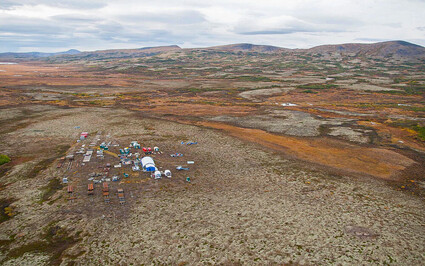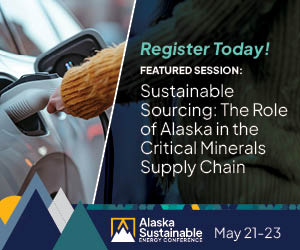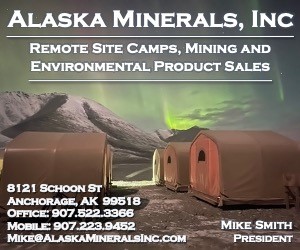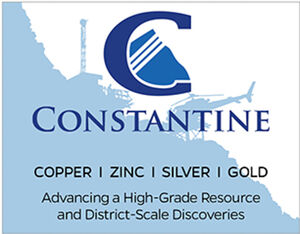Pebble: Origins of the enduring controversy
Explore the beginnings of the Pebble Mine, Alaska's statehood, resource rights, and the battle for environmental preservation North of 60 Mining News - November 3, 2023
Last updated 11/2/2023 at 12:42pm

KDLG Public Radio; Jason Sear
Found due to color anomalies from aircraft, credited discoverer Phil St. George originally called it the "Pebble Beach Prospect," because of its similarity to the famous golf course.
Navigating the tumultuous waters of controversy and impassioned discourse, let us take a step back and embark on a journey through the history of an Alaska copper project that has proven to be as divisive as it is essential. Perhaps by exploring the compelling narrative of the Pebble Mine project, where the pursuit of precious resources indispensable for a zero-carbon future intersects with the call for environmental stewardship to safeguard heritage and a very way of life, will give some perspective to a story that reverberates far beyond Alaska's boundaries, and as far back as the territory's welcoming as the 49th state of America.
With current tensions high due to perceived encroachment by the Environmental Protection Agency and its decision to sanction Alaska-owned lands through an authority in protecting national waters, the state has begun a process that takes the case to the highest judicial seat in America.
While the present situation is a result of years of complex political maneuvering and shifting public opinion, it actually goes back even further to before the discovery of Pebble itself.
Interestingly, it is through a series of seemingly unrelated events that a more complete picture of the Pebble project and the state's legal rights can become better understood.
And so, this understanding begins amidst the historical backdrop of Alaska's path to statehood, where the rights ratified in the founding constitution laid the groundwork for exploration of the present-day dispute.
Journey to statehood
Perhaps through wisdom, intuition, a keen understanding of human nature, business acumen, or just plain common sense, the initial agreement that led to the formation of Alaska as the 49th state of America included a means of protecting itself from outside influence – or, more crudely, plundering.
While Alaska became a state in 1959, the movement for statehood began nearly 20 years earlier. However, opposition from commercial interests and some members of Congress down south stymied progress toward getting such a dream realized.
Foreseeing the value of the territory and the need for the rights provided an official member of the U.S., many proponents felt that a well-written constitution would help advance the cause in Washington, D.C.
As a result, the Alaska Territorial Legislature formed the Alaska Statehood Committee to "assemble applicable material, make studies and provide recommendations in a timely manner" preparatory to drafting a constitution.
After years of painstaking work and coordination, especially in a state as difficult to travel in as Alaska, on November 8, 1955, 55 delegates from across Alaska met at the newly erected student union building, dubbed Constitution Hall, at the University of Alaska, Fairbanks.
Over a period of 75 days, the delegates drafted a 100-page, 26,000-word document that drew on several sources for inspiration, including the United States Constitution.
Considered half the average state constitutional length, one of the aims of the members was to produce a short, general document rather than specify most aspects in minute detail, choosing to leave broad authority to future state legislatures.
Covering aspects such as Alaska's Declaration of Rights, various branches of government like legislation, executive and judiciary power, voting, elections, health, education, and welfare, the eighth article of the constitution was drafted to deal solely and broadly with resources.
Wishing to curtail what they viewed as an abuse of Alaska's resources (which actually came about from exploitative fishing practices from outside fisheries), this section was written in hopes to ensure reasonable development to broaden Alaska's economic base.
The chief principle was that resources should be managed as a public trust, providing "for maximum use consistent with the public interest," further defined as "utilization, development, and conservation ... for the maximum benefit of [the] people"; for common access to resources; and for development to be based on sustainable yield.
Within this article were also provisions for state parks and protected areas, as well as for leasing of state lands for resource development.
With all this work done, however, no matter how well conceived a constitution, Alaska would not see statehood without help from movers and shakers, or rather, those with deep pockets. Who, then, has deeper pockets than the military?
It must be remembered that around the time this was happening, America was showing its industrial might during the Second World War.
As the ensuing years saw a closing of the second edition of the war to end all wars with America's decisive nuclear strikes on Hiroshima and Nagasaki, the might of the atom was revealed, which ushered in a period that still affects the sensibilities of modern Americans – otherwise known as the Red Scare.
This was the Cold War.
Cold War not cold for Alaska
During the Cold War, Americans called Alaska the "Guardian of the North" and "Top Cover for America" because it was the first line of defense against our nuclear adversary, Russia.
Realizing the strategic value of Alaska during the era's early years, the U.S. military mobilized to create a defensible position at the shortest and most likely route of attack from the Soviet Union. Hence, the military invested heavily in Alaska's defensive position.
While Alaska was important to the U.S. during the war, conversely, the strong military presence was also invaluable to Alaska. The Cold War is the reason many roads, railroads, and communities in Alaska were built, and the infrastructure that the military built in the state encouraged Americans from the" Lower 48" to move to Alaskan cities.
Due to the boom in development and influx of people, Alaska's population tripled between 1945 and 1970, growing from 79,000 people to 220,000. The population also became more diverse. Military personnel and their families moved to Alaska from all over the U.S., with more than half of the population in some of Alaska's remote communities working for the military.
All in all, Alaska's growth and strategic importance led to the territory becoming a state in 1959. Even with internal support from territory leaders, some long-time residents, businesspeople, members of Congress, and even President Eisenhower did not want Alaska to become a state.
Political economist George W. Rogers wrote in 1962, "Without the influx of new population and prosperity brought in by Military Alaska, it is doubtful that Alaska would today be a state."
Even still, with these seemingly serendipitous events culminating into a recipe for the eventual approval of Alaska becoming a state, the battles were still far from over.
One of America's largest land swaps
After the passage of the landmark Alaska Native Claims Settlement Act of 1971, which by itself was a hard-fought battle by Indigenous Alaskans to retain their ancestral homelands, one of the 12 land-owning Alaska Native regional corporations was left between a rock and a hard place.
Cook Inlet Region, Inc., better known as CIRI, expected to receive 1.25 million acres of surface estate and 2.25 million acres of subsurface estate within the Southcentral Alaska region. There was only one problem – the CIRI region was already well-established and covered the most populated part of the state.
Faced with the reality that much of this land was already in the hands of private, state, and military or was off-limits as national parks or due to protected wildlife, this ultimately left CIRI with glaciers and mountaintops for land entitlement selections.
Refusing to accept what it viewed as inadequate selections, the corporation began another battle to obtain lands outside its delegated region of Southcentral Alaska and for resource-rich areas that could support its people and their way of life.
Through vision and perseverance, as well as nearly four more years after the initial ANCSA settlement, CIRI brokered a new deal.
The Cook Inlet Land Exchange would become a three-way land swap between Alaska, CIRI, and the federal government that would help lay the foundation for the Alaska Native corporation's future successes, especially a solid financial grounding.
Now inked as law, a portion of the lands exchanged to the state was later found to host enormous quantities of copper and other metals, which would later become known as Pebble.
With the shuffling ended to the benefit of all parties, it would seem that all the hullaballoo would finally be over. But, a discovery made in the 1980s would set in motion a nearly 20-year fracas for mineral development in Southwest Alaska.
The copper fairway
In the remote wilderness of Alaska, the Pebble project owes its existence to an unlikely result not often seen in mineral exploration – simply asking – and sometimes you get lucky.
Uncovered in 1987, the usual account of Pebble's discovery is attributed to geologist Phil St. George, who, after witnessing ground color anomalies visible from aircraft, spearheaded early exploration efforts that unearthed roughly 500 million tons of potentially mineable ore.
Led by Cominco Alaska Exploration – now known as Teck Resources, which operates the Red Dog zinc mine – the first two exploration holes were drilled the following year, twelve more in 1989, along with soil sampling and geophysical surveys.
Undergoing the typical exploratory rigmarole, this early work indicated that the deposit was part of a large copper porphyry system. Continuing its exploration through 1992, with a second drill campaign in 1997, the resource doubled from 500 million tons to 1 billion.
However, an unusual recounting of the discovery of Pebble shows that St. George asked a local pilot about strange discolorations he might have seen, which paints a slightly different shade to the origins of Pebble.
In an investor write-up regarding the acquisition of the Big Chunk project in the Lake Iliamna region of Southwestern Alaska in 2008, now-retired James Briscoe of Arizona-based Liberty Star Uranium and Metals Corp. provided his recollection of the Pebble project's initial discovery:
"The Pebble deposit, currently owned by Northern Dynasty Minerals Ltd., has an interesting story of discovery. During the late 1980s Cominco Geologist Phil St. George, was gold prospecting in the Lake Iliamna region of south western Alaska. Phil asked a local bush pilot if he had ever seen any red areas during his many flights. The local pilot told Phil he had seen red rocky formations in a remote area where the air traffic was sparse enough to safely practice aerobatics. Phil took the passenger's seat in the bush pilot's small plane as they flew over the area the pilot talked about. Phil decided the red alteration just barely exposed through the tundra-covered terrain merited a closer look. Phil conducted basic surface studies and undertook a small drilling campaign of 7 helicopter supported diamond drill holes. From this initial examination Phil concluded that the area was a porphyry system, not the gold system he had set out to find. With its flat beach-like terrain, the project area reminded Phil of a famous golf course so he named it the 'Pebble Beach Prospect'."
In 2001, Northern Dynasty Minerals Ltd. optioned the property from Teck Cominco, the successor to Cominco Alaska Exploration's parent company.
Beginning its own exploration efforts in 2002, the project has had its ups and downs but has persisted for nearly two decades.
Once partnered with some of the biggest players, garnering hundreds of millions of dollars in support and investment, due to continued pressure against the project, lengthy permitting processes, and general uncertainty on Pebble ever actually starting up, most have pulled out, leaving Northern Dynasty alone in its attempt to push forward the largest known undeveloped copper ore body in the world.
Waning enthusiasm
During its earlier years, due to the growing excitement for such a rich and massive deposit, various companies sought investment in the project.
One such company was mining giant Anglo American, which approached Northern Dynasty to earn 50% in a newly devised Pebble Limited Partnership, with the other 50% to belong to Northern Dynasty.
Holding title as one of the largest multinational mining corporations at the time, under the partnership, Anglo America spent over half a billion dollars between 2007 and 2013. However, by December of its final year, Anglo walked away from the project, losing its 50% interest, which reverted 100% to Northern Dynasty.
Before companies began to jump ship, three of the world's largest mining companies purchased shares of the company or became partners in Pebble Limited Partnership through obligations to fund exploration and development. One of them being Rio Tinto.
In the end, however, all have since divested their interests.
As excitements began to wane, Northern Dynasty has continued to push through, even despite a massive scandal involving a series of dubiously recorded conversations between purported Environmental Investigation Agency investigators and the former CEO of Pebble Limited Partnership, Tom Collier, who resigned after information got out that Pebble was attempting to mislead potential investors.
Nevertheless, Northern Dynasty and Pebble Partnership has maintained a moral high ground and has continued to seek investment and development. This has been spurred by its most recent funding of $9.4 million from a private asset management company in 2022.
The reason Pebble has persisted through four decades of highs and lows, including a controversy that has reached global proportions, is the unparalleled deposit of metals found there.
The world-class deposit at Pebble hosts 6.5 billion metric tons of measured and indicated resources averaging 0.4% (57 billion lb) copper, 0.34 g/t (71 million oz) gold, 240 ppm (3.4 billion lb) molybdenum, 1.7 g/t (345 million oz) silver, and 0.41 ppm (2.6 million kg) rhenium.
The Southwest Alaska deposit hosts another 25 billion lb of copper plus associated metals in the inferred resource category.
However, in the end, the issue has always been regarding permitting and the potential risks mining these precious and critical metals presents the Bristol Bay region, which is also home to the world's largest sockeye salmon fishery, and with the final decision made by EPA in January, it appeared the final nail had been driven into the coffin.
A constitutional case
Full circle, the present issues surrounding the Pebble Mine project in Alaska are intricately linked to the statehood act of Alaska.
The Alaska Statehood Act of 1958, which paved the way for Alaska to become the 49th state of the United States, granted the state and its people significant rights and responsibilities regarding their lands and resources. It included provisions recognizing Alaska's authority over the management and control of its resources, particularly its minerals.
This legal framework, while granting Alaska a greater degree of autonomy, also established a foundation for the state's responsibility in making decisions about resource development and land use.
Consequently, the ongoing debates and regulatory processes related to Pebble reflect the intricate relationship between state and federal authorities, local interests, and the management of Alaska's vast and valuable natural resources.
At present, the state is gearing itself to begin litigation with the EPA, which issued a final determination for the Bristol Bay watershed at the end of January. This decision to lock away 309 square miles of state lands was made under its asserted authority under the Clean Water Act, more specifically, Section 404(c).
How did this impact the Pebble project?
Well, setting aside the chain of events that led to EPA's decision, this move effectively prohibits permitting a mine at the world-class copper deposit due to its proximity to now-protected waters, essentially barring any further opportunities that would allow the project to begin operations.
However, this is where things began to escalate, and with EPA's decision, the state has made a case that its founding charter has been invalidated, and either recourse or reversal of the decision must occur.
Alaska Attorney General Treg Taylor filed a motion for leave – essentially a legal procedure that asks the court permission to deviate from established rules – with the U.S. Supreme Court that strongly argues that EPA's veto of the Pebble project is a breach of contract between Alaska and the U.S. and violated the federal statutory recognition and implementation of the Cook Inlet Land Exchange.
By taking the unorthodox approach of bypassing the lower courts and going straight to the Supreme Court, Alaska hopes to assert its sovereignty when it comes to managing state lands, especially lands that host more than half a trillion dollars of copper, gold, molybdenum, and other metals.
"An original action, where a case is heard directly by the Supreme Court instead of first progressing through the lower courts, is an extraordinary ask, but it's appropriate given the extraordinary decision being challenged," said Attorney General Treg Taylor.
In his brief, Taylor was concise in the state's concerns.
"No other State in the union depends so greatly on its lands for its prosperity," the brief contends. "Unlike most States, Alaska is constitutionally required to protect its natural resources. The State must provide for the 'conservation of all natural resources belonging to the State, including land and waters, for the maximum benefit of its people.'"

The Seattle Times; Mark Nowlin via Esri
Map showing the area restricted by EPA that would block Pebble, as it falls into the main deposit area.
Nonetheless, EPA vetoed Pebble Limited Partnership's plans for mine development before state procedures could perform its due diligence for the project on Alaska lands.
In the end, as we delved into the history of Pebble, it hopefully became clear that the controversy surrounding this project is part of a larger issue.
With the present problem contingent on the hasty actions of federal oversight – making unilateral decisions that not only strike at the heart of Alaska's sovereignty but also puts at risk future liberties – ultimately, this ongoing story serves as a stark reminder that, regardless of one's stance on Pebble, the question of who has the authority to dictate its fate is a matter that demands attention and deliberation.

















Reader Comments(0)